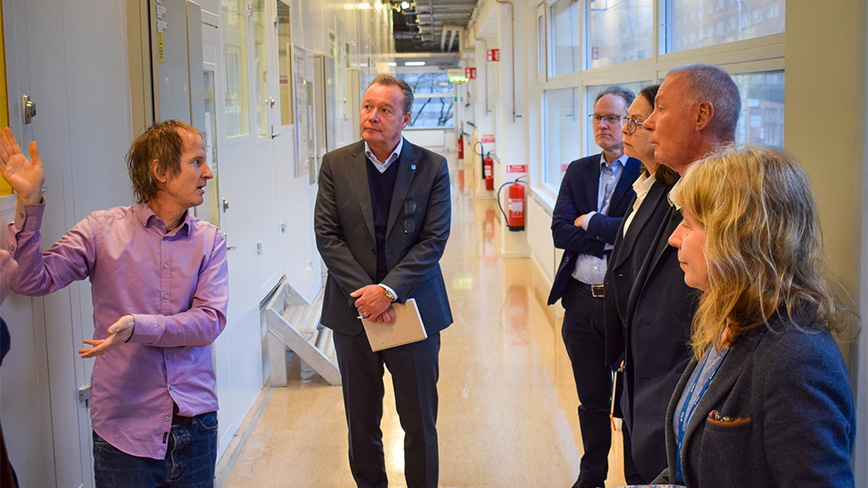Det här presenterades på rektorns besök i Kista
Rektor och ledning

Nya labb-kit för studenterna, skolans senaste satsningar och KTH:s största forskningsinfrastruktur. Detta och mer fick rektor Anders Söderholm se när han besökte KTH Kista tisdagen den 10 januari.
Sedan Anders Söderholms tillträde som rektor i december har han besökt alla KTH:s skolor. Nu besöker han alla externa campus, varav Kista är ett av dem. Framöver kommer han att besöka alla institutioner på universitetet.
- Det är otroligt intressant att få se verksamheten och systemet kring utbildning, infrastruktur och forskningscentrum, säger Anders.
Under dagen fick han besöka Electrumlaboratoriet, forskningscentrumen Senseable Stockholm Lab och Semiconductor Reseach Centre, se de olika utbildningsmiljöerna och träffa föreståndare och avdelningschefer.
Samhällsnära forskning och undervisning
Vår skolchef Sonja Berlijn inledde dagen med en presentation av EECS verksamhet i Kista. Här finns institutionerna Elektroteknik och Datavetenskap representerade genom avdelningarna Kommunikationssystem, Programvaruteknik och datorsystem samt Elektronik och inbäddade system.
- För att kunna bedriva samhällsnära forskning försöker vi ha ett forskningscentrum till varje institution. Därför är vi extra stolta över våra två forskningscentrum Senseable Stockholm Lab och Semiconductor Reseach Center, säger Sonja.
Här utbildas också 1200 studenter i två högskoleingenjörsprogram, ett kandidatprogram, ett civilingenjörsprogram, fyra masterprogram och ett doktorandprogram. I lokalerna finns flera förstklassiga utbildningsmiljöer, däribland Mentorspace för elektronikstudenter och kommande D-Lab mer inriktat mot datastudenter.
Dessutom har vi även en av KTH:s största forskningsinfrastrukturer, Electumlaboratoriet. Nils Nordell, föreståndare för labbet presenterade deras arbete.
- Vi skapar en miljö för utbildning, forskning och hela vägen till småskalig produktion. Vi har varit en integrerad del av KTH Kista sedan 1987, säger Nils.
Idag har Electrumlaboratoriet sex anställda och cirka 180 användare från både företag och akademi som jobbar med allt från medicinteknik till kiselkarbid för energilösningar och ir-sensorer för värmekameror.
Institutionen för Intelligenta system, och specifikt dess avdelning för Mikro- och nanosystem, är den mest frekventa labbanvändaren och bedriver en stor del av sin forskning här.
- En så stor infrastruktur behöver många användare, och vi ser det därför som väldigt positivt att det nya forskningscentret för halvledare startas, för att attrahera nya användargrupper, tillägger Nils.
Skolans senaste forskningssatsningar
Föreståndare för det nya centrat Semiconductor Research Center, Per-Erik Hellström, berättar:
- Min ambition är att skapa ett landskap mellan KTH:s akademi, Elektrumlaboratoriet och externa parter, säger Per-Erik
Centrat är nu är vi inne i en två år lång interimperiod där forskningen ska växa fram i samarbete med samarbetspartners och forskningsprogram.
- En av de viktigaste poängerna är att koordinera alla intressenter inom området så att vi kan arbeta aktivt för att kunna generera större forskningsprojekt. Målet är att stärka halvledarområdet både här och nationellt i Sverige, avslutar Per-Erik.
Anne Håkansson, föreståndare för Senseable Stockhom Lab, presenterar forskningscentrets arbete.
- Forskningen som bedrivs på centrat handlar om att känna in staden. Det är en spegling av MIT:s Senseable City Lab. MIT jobbar främst med programmering och visualisering och vi jobbar med områdeskunskap, data och teknik, säger Anne.
Centrats största mål är att hjälpa Stockholms stad att bli en bättre, smartare och effektivare stad. Tidigare har de jobbat med Hammarby sjöstad. Nu ska de utveckla Kista.
Forskningen ska ta fram ny kunskap och nya metoder för att kunna planera för en mer hållbar stad. Det innebär bland annat etik i datahantering och utveckling av idéer till konceptet 15-minutersstaden; ett urbant koncept där de flesta dagliga behov kan utföras genom att antingen gå eller cykla från invånarnas hem.
- Vi jobbar mycket med att ta fram kunskap som är relevant för Stockholm Stad. I Kista kan det kan innebära att forska i hur vi skapar trygghet och minskad segregering. Vi är duktiga på att samarbeta med företagen runt omkring oss vilket är en otrolig möjlighet för våra studenter och forskare, säger Anne.
En av utmaningarna framåt är att involvera studenter och forskare i större utsträckning. Under våren kommer det därför bland annat hållas lunchseminarier för studenter inom mjuk- och hårdvara på KTH Kista.
Utbildning i framkant
Institutionen för elektroteknik finns representerade i Kista genom avdelningen Elektronik och inbyggda system. Prefekt Hans Edin och avdelningschef Carl-Mikael Zetterling presenterade arbetet.
- Flera av våra kurser har labbkit som studenterna kan jobba med hemma eller på skolan. Bland annat får studenterna experimentera med digital design och ellära via ett labbkit som enkelt drivs via den egna datorn, säger Carl-Mikael.
Intuitionen erbjuder också flera livslångt lärande-kurser. Dessa är kurser som redan hålls för programstudenter men som öppnas upp som fristående kurser i syfte att kompetensutveckla yrkesverksamma. Dessutom erbjuds en helt ny kurs för gymnasielärare i elektronik och programmering.
Från institutionen Datavetenskap presenterade Anders Västberg, avdelningschef för Kommunikationssystem, och Thomas Sjöland, avdelningschef på Programvaruteknik och datorsystem.
Programvaruteknik och datorsystem är en av EECS största avdelningar med ett tiotal professorer, ungefär lika många lektorer och några adjunkter.
De två avdelningarna har tillsammans totalt 70 doktorander som arbetar i 10–12 forskargrupper. Totalt har de två avdelningarna 60 kurser på grund- och avancerad nivå med 700 helårsstudenter. De hanterar 120 examensarbeten på grundnivå och 120 examensarbeten på avancerad nivå.
- Våra lärare undervisar både på KTH Kista och KTH Campus. Dessutom har vi kurser med god koppling till våra aktuella forskningsområden såsom distribuerade system för molntjänster, högeffektiva kommunikationssystem, djup maskininlärning och AI till exempel för biomedicinska tillämpningar, säger Thomas Sjöland.
Rektor Anders Söderholm avslutar med att tacka för besöket och mottagandet.
- Jag tar med mig hur viktigt det är att få våra samarbeten att flyta på smidigt och Kistas möjlighet att utvecklas som campus. Jag ser fram emot framtida samarbete, avslutar Anders.
Charlotta Alnersson
